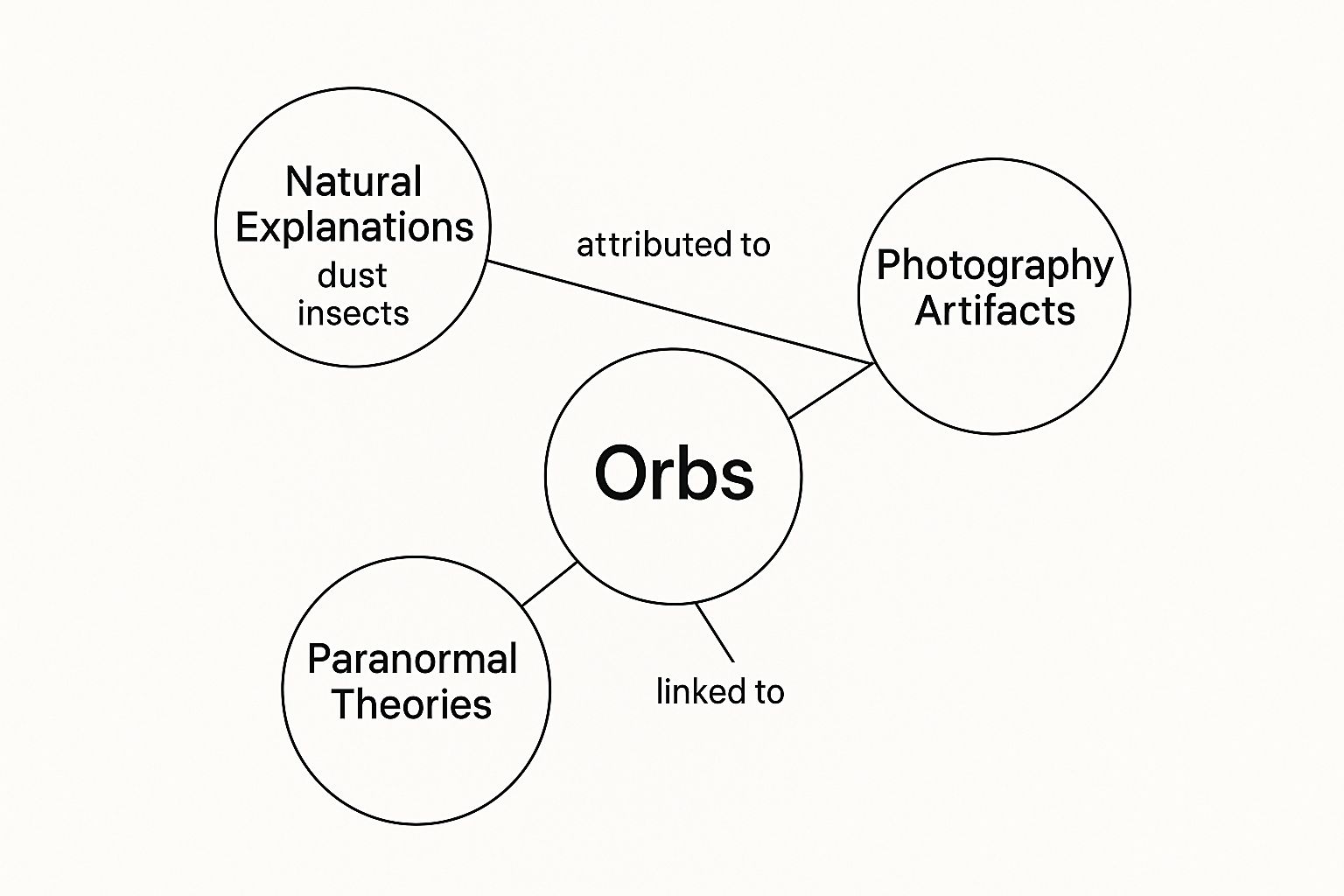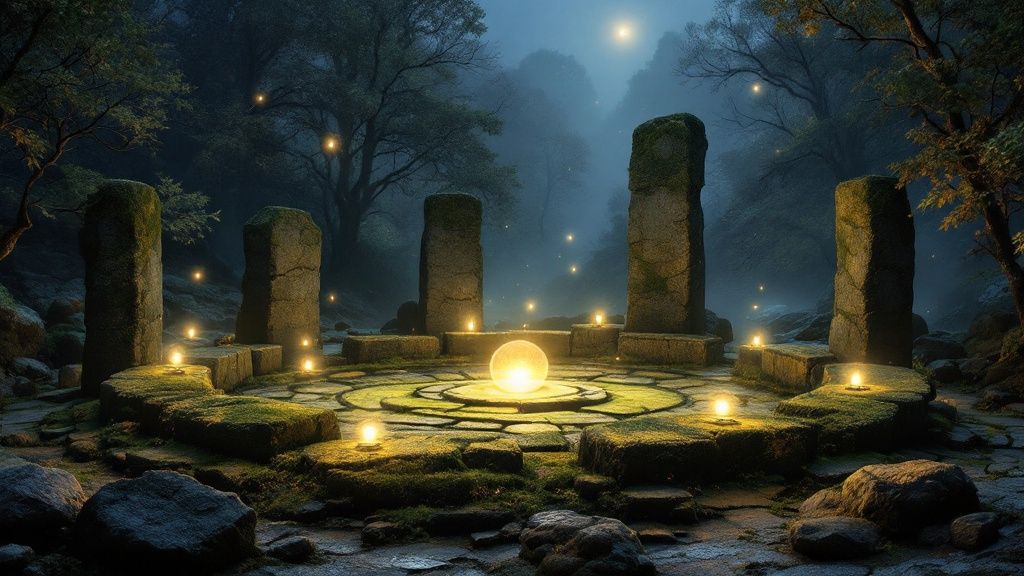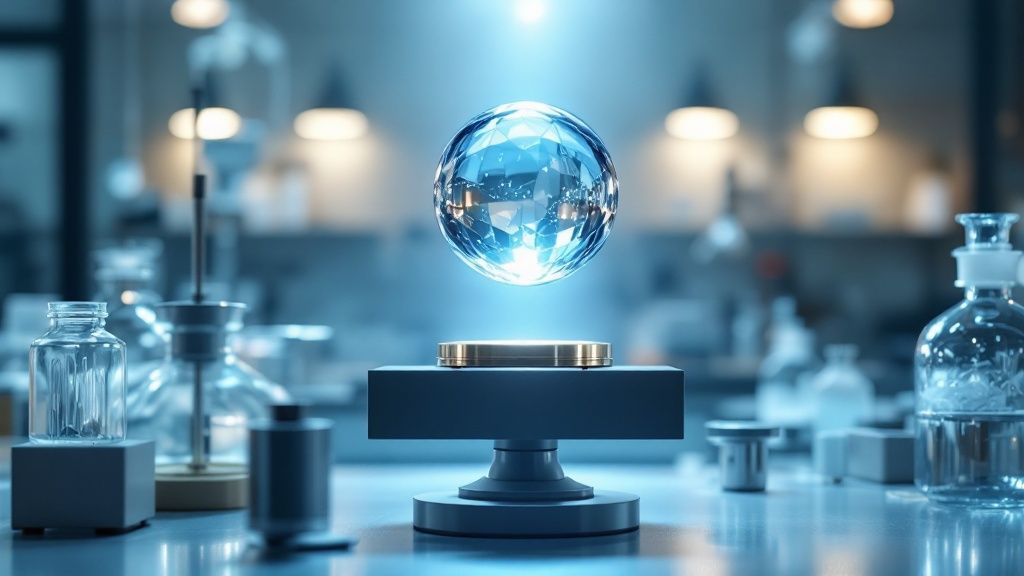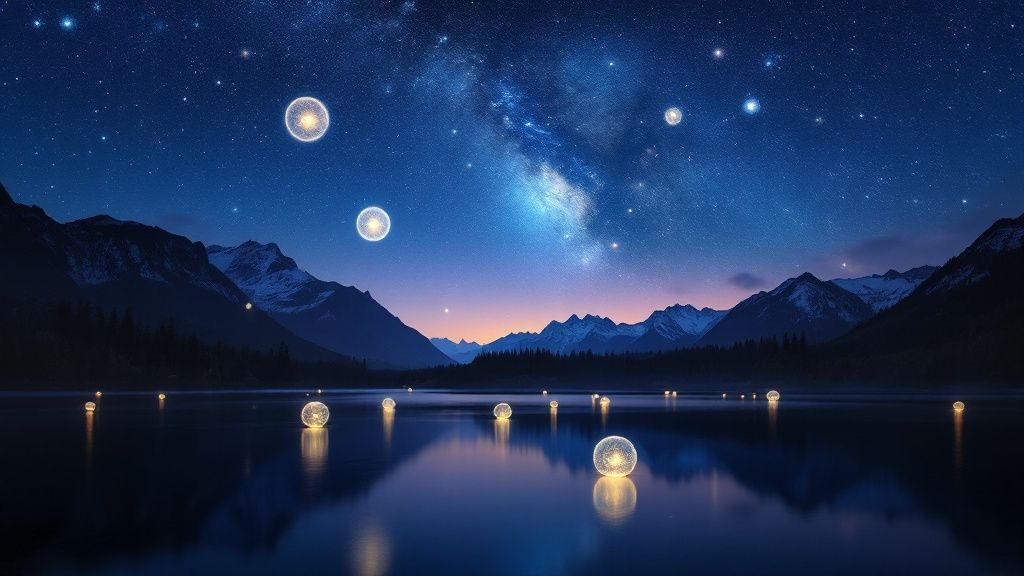So, What Exactly Are These Orbs?
The question “what are spirit orbs?” really opens up a fascinating debate, one that sits right on the fence between hard science and the supernatural. A 2018 survey on paranormal beliefs in the UK found that over 40% of people believe in ghosts, showcasing a widespread fascination with phenomena like orbs. For every person convinced they’ve captured proof of the afterlife, there’s someone else ready with a perfectly logical, down-to-earth explanation. It’s this mystery that makes these captivating little spheres so intriguing to believers and sceptics alike.
Before you can decide what you think, it’s crucial to understand both sides of the coin. Are they just out-of-focus dust motes caught in the flash, or could they genuinely be something more? Think of this guide as your practical toolkit for figuring out what you’re looking at.
Three Main Theories on Where Orbs Come From
When an orb appears in a photo, its origin usually falls into one of three distinct categories, each with its own compelling arguments. Understanding these is the first step in any practical analysis.
- Natural Causes: This is all about the environment. The most common culprits are things floating in the air – tiny specks of dust, pollen, minuscule insects, or even fine moisture from rain or mist. Practical example: If you take a photo in a dusty attic right after moving a box, the air will be filled with particles, making orbs highly likely.
- Photographic Glitches: Sometimes, the camera is to blame. Things like lens flare, reflections happening inside the lens itself, or even tiny flaws on the camera’s sensor can produce circular shapes that look exactly like orbs. Practical example: Pointing your camera towards a bright security light can easily create a lens flare that appears as a multi-coloured orb in the final image.
- Paranormal Activity: This is the theory that suggests orbs are the visible energy of spirits, a deceased person, or another kind of non-physical entity. Proponents of this view often believe that a sphere is the most efficient shape for a spirit to manifest, requiring the least amount of energy.
This simple diagram helps to visualise the three main possibilities you should consider when you spot an orb.

As you can see, any serious investigation into an orb photograph has to weigh up all the options before jumping to conclusions.
And while digital cameras have made orb photos a modern phenomenon, our fascination with mysterious lights is nothing new. In fact, reports go way back. In January 1254, a scribe at St Albans Abbey noted seeing a “glowing floating light” which he described as looking like “a kind of large ship elegantly shaped, well equipped and of marvellous colour”. You can read more about these historical UK sightings and the context around them. It just goes to show that we’ve been looking up at the sky and seeing strange things for centuries.
Quick Guide to Identifying Photographic Orbs
Trying to figure out what you’ve captured can be tricky. This table provides a quick reference to help you start distinguishing between a potentially paranormal orb and one with a more mundane explanation.
| Orb Characteristic | Potential Paranormal Indication | Common Natural or Technical Cause |
|---|---|---|
| Movement | Appears to move with intelligence or purpose across a series of photos. | A bug or piece of dust drifting on an air current. |
| Colour & Complexity | Shows intricate internal patterns or a distinct, self-contained colour. | Often a solid, washed-out white or translucent. |
| Light Source | Emits its own light, appearing bright even without a flash. | Caused by direct reflection of the camera’s flash. |
| Location | Appears in a specific, meaningful spot (e.g., over a particular grave). | Randomly distributed across the image frame. |
| Consistency | Shows up in the same place across multiple photos, even from different angles. | Appears in one shot but not the next, or its position is inconsistent. |
Remember, this is just a starting point. The best approach is to be a good detective: look at all the evidence, consider the environment you were in, and rule out the simple explanations first.
The Science of Orbs and Photographic Glitches

Before we start seeing spirits in every speck of light, it’s vital to put on our detective hats. We need to look at the common, perfectly logical reasons why these “orbs” pop up in photos. The truth is, the vast majority of orb pictures are just simple tricks of the camera. Getting to grips with these principles is the first step to analysing your own photos with a properly critical eye.
The most common explanation by a country mile is a phenomenon called backscatter. This happens when your camera’s flash bounces off tiny particles floating right in front of the lens. Because they’re so close, the camera can’t focus on them, turning them into those familiar bright, circular, and often see-through blobs we call orbs.
Actionable Insight: Before your next investigation, take a practical test. Go into a dark room, shake a dusty cushion in front of your camera, and take a flash photo. The resulting image, filled with “orbs,” will serve as your personal reference for what simple dust backscatter looks like with your specific camera.
Common Culprits of Backscatter
So, what are these mystery particles? You’d be surprised. They’re everywhere, but they’re especially common in the kinds of old, atmospheric places people love to investigate.
- Dust and Dander: Old buildings are full of dust. A study by the Indoor Air journal found that an average home can accumulate up to 40 pounds of dust per year. Just walking across a creaky floorboard can stir up a cloud of these particles, each one a potential orb.
- Pollen and Spores: If you’re taking pictures outside, especially in gardens or forests, the air is thick with pollen. Go into a damp, musty cellar, and you’ll find mould spores doing the very same thing.
- Moisture Droplets: Even the air itself can be the culprit. A light mist, high humidity, a bit of drizzle, or even your own breath on a chilly night can create a fog of tiny water droplets, all perfectly shaped to reflect light.
- Insects: A gnat or a tiny moth zipping past the lens at the moment the flash goes off can easily be mistaken for an orb. Their quick movement often creates a blurry circle or streak of light.
“Essentially, the camera is seeing what our eyes are trained to ignore. We don’t notice the millions of tiny particles floating around us every day, but a powerful flash close to the lens makes them impossible to miss.”
Beyond Backscatter: Other Photographic Glitches
While backscatter is the main offender, it’s not the only one. Other technical hiccups can create orb-like spots in your photos. Lens flare is a classic example. This happens when a bright light source, like the sun or a security light, shines directly into the lens, causing internal reflections that often show up as geometric or circular patches of light.
Most of the scientific explanations boil down to how light plays with particles close to the camera. Brushing up on some general photography lighting tips can really help you understand these optical effects. By methodically ruling out all these logical causes first, you build a much more compelling case if you ever do capture something you truly can’t explain.
Exploring the Paranormal Theory of Spirit Orbs

So, you’ve carefully checked your camera settings and ruled out every logical, scientific explanation for that strange light in your photo. What’s left? This is the point where many paranormal investigators shift their thinking. The anomaly moves from being a simple camera glitch to potentially being a sign of a spiritual presence. This is where the paranormal theory of spirit orbs really begins.
This perspective isn’t just about seeing lights; it suggests that certain orbs are the visible form of a spirit’s energy. Many people who subscribe to this theory believe spirits manifest as spheres because it’s the most energy-efficient shape. It takes an immense amount of energy for a spirit to appear in our physical world, and a sphere, with no edges or corners, allows that energy to exist in a stable, uniform state.
Characteristics of a Genuine Spirit Orb
Not every circle of light you capture is paranormal. Those who have spent years in the field learn to spot specific qualities that set a truly intriguing anomaly apart from a speck of dust. If you’re trying to understand what are spirit orbs, these are the features to watch for.
- Internal Structure or Detail: A simple dust orb looks flat and translucent. A potential spirit orb, on the other hand, often seems to have depth. Practical example: Zoom in on your photo. Do you see textures, complex patterns, or what almost looks like a miniature, swirling planet inside? This detail is what investigators find compelling.
- Self-Illumination: Does the orb look like it’s just reflecting your camera’s flash, or does it seem to be glowing on its own? A true spirit orb often appears solid and bright, emitting its own light, even in photos taken with no flash at all.
- Intelligent Movement: This is often cited as the most compelling evidence. Practical example: If you capture an orb on video and it appears to move with purpose, ducking around furniture, approaching a person, or zig-zagging instead of just floating by, it becomes much harder to dismiss as a random particle.
The paranormal theory doesn’t just see orbs as random lights; it interprets them as conscious energy. The idea is that these are not just remnants, but potential attempts at communication from another plane of existence.
Energy and Environment
The idea of spirits being pure energy is at the very heart of this theory. It’s why investigators are so often obsessed with environmental energy, using tools like EMF meters to detect fluctuations. Spirits, in theory, draw on and manipulate this energy to manifest. For those interested in the energetic side of spirituality, crystals like Black Tourmaline or Selenite are often used for protection and clearing space. You can explore a selection of these at online shops like The Psychic Tree.
If you’re exploring the possibility that spirit orbs are energetic phenomena, you might find it useful to look into methods for clearing negative energy from a house, as the principles are closely related. Of course, all of this feeds into the much bigger and more complex debate over is paranormal activity real?
How to Responsibly Photograph Potential Orbs
Ready to put the theory to the test? Proper paranormal investigation is about methodically ruling out the ordinary. That’s how you can tell the difference between a lucky snap and something that might genuinely be evidence.
The first, and most important, step is preparation. Before you even touch your camera’s settings, make sure your lens is absolutely spotless. A single speck of dust can look exactly like an orb when your flash hits it.
Actionable step: Use a microfibre cloth and lens cleaning solution. This simple act immediately eliminates the number one cause of false orbs.
Setting Up Your Investigation Space
To create a controlled environment, you first need a clean slate. Before you start your investigation, take a few “control shots” of the empty room with your flash on. This gives you a baseline, showing you what the space looks like normally.
Then, try the ‘dust test’ used by seasoned investigators. After getting your baseline shots, give a dusty rug a good shake in the air and take more photos. Your pictures will almost certainly be full of orbs. Now you have a perfect visual guide for what mundane dust looks like on your camera in that environment.
Essential Camera and Equipment Settings
With the space prepped, it’s time to get your gear sorted. While almost any camera can technically capture an orb, a DSLR or mirrorless model with manual controls will give you the most reliable results. If you’re getting serious, consider investing in specialist ghost hunting equipment.
Here are the key settings to get right:
- Use the Flash (Strategically): By using the flash on purpose, you can compare shots taken with it to those taken without. If a strange light appears in both, that’s much harder to explain as simple backscatter.
- Adjust ISO and Shutter Speed: Keep your ISO relatively low (around 400-800) to minimise digital noise. A slightly slower shutter speed, maybe 1/30s, will let more light in, but you’ll need a tripod to keep things sharp. You can find sturdy, professional-grade tripods on sites like Amazon.
- Take Comparison Shots: One photo is never enough. Always take at least three pictures of the same spot, one right after the other. A real anomaly might appear to move with purpose or stay put, while a dust mote will just drift randomly.
- Document Everything: Keep a log of the conditions. Note the temperature, humidity, and any readings from an EMF meter. A good EMF meter, like the K-II, is a core piece of kit, and you can find reliable models at specialist shops like GhostStop.com. This data provides crucial context.
The goal is not just to capture a strange light but to systematically eliminate every possible mundane explanation. Only then can you begin to consider the possibility that you’ve documented something truly unexplained.
It’s worth remembering that some orb-like phenomena, such as ball lightning, have puzzled UK researchers for a long time. These aren’t ghosts, but they are very real. Scientists have even clocked these phenomena moving at over 1,200 metres per second—more than three times the speed of sound. You can read more about these real but unexplained phenomena on Science Focus. By being rigorous, your own investigation becomes part of this fascinating quest for answers.
Looking Closer: How to Analyse and Interpret Your Orb Photos

Catching an orb in a photo is a thrill, but the real work starts when you sit down to figure out what you’ve actually captured. The key is to approach it with a framework for analysis, looking at the evidence with both a critical and an open mind.
The first step is to get granular and scrutinise the orb’s visual traits. Don’t just stop at its circular shape; zoom in and look at its specific qualities. A simple, see-through circle is almost certainly a dust particle. But what if it looks solid, seems to glow with its own light, or has intricate patterns inside? That’s when things get interesting.
Key Characteristics to Look For
When you’re reviewing a photo, don’t be afraid to zoom right in and examine the details. Every investigator has their own checklist, but most agree on a few key features that can help tell the difference between a simple camera glitch and something potentially more significant.
- Colour: Most orbs are white, but sometimes they appear in different colours. Within paranormal circles, these hues are often given specific meanings – blue might suggest calmness, green could mean healing, and red often points to strong emotions. Sceptically, these colours can be light refracting through different airborne particles.
- Transparency: Can you see right through the orb? As a general rule of thumb, the more solid and opaque an orb appears, the more weight it carries for paranormal researchers.
- Size and Location: Take a moment to see where the orb is in the photo. Is it just floating randomly, or does it seem to be interacting with its surroundings, perhaps hovering over a particular person or object? Its size relative to other things in the picture also provides context.
The most crucial part of this whole process is objectivity. The goal isn’t to force the evidence to fit a ghostly narrative. It’s about seeing where the evidence leads after you’ve ruled out every logical explanation.
Understanding Movement and Context
Did you catch the orb on video or in a burst of photos? If so, its movement is one of the biggest clues you have. Practical analysis: Plot the orb’s path across three consecutive photos. Does it follow a logical arc like a thrown piece of dust, or does it change direction sharply? An anomaly that moves with what looks like intent is much harder to explain away.
The context of the photo is just as vital. Where were you when you took it? What was the mood like? It’s important to remember that our own feelings can colour how we see things. Grasping the difference between your perception vs perspective is a fundamental skill for any investigator. By weaving together a detailed visual analysis with a clear picture of the environmental and emotional setting, you can arrive at a more thoughtful and credible interpretation.
Got Questions About Orbs? Let’s Get Them Answered
Alright, let’s dig into some of the most common questions that pop up when talking about orbs. This is where we can clear up some of the finer points and address those nagging queries that might still be on your mind.
We’ll be looking at things like orb colours, whether you can see them without a camera, and why certain spooky places seem to be absolute hotspots for orb activity.
Do Coloured Orbs Mean More Than White Ones?
Within the paranormal community, the colour of an orb is often believed to hint at the nature of the energy present. A brilliant white orb is often seen as a sign of positive energy or a protective spirit. A blue orb might be interpreted as a calm, guiding presence, while green is frequently tied to nature spirits or healing energies.
From a photographic perspective, however, there are plenty of technical explanations. The colour could be the result of your camera’s flash refracting through a specific type of airborne particle, the unique chemical composition of a speck of dust, or even just an artefact created by the camera’s sensor.
A coloured orb is undoubtedly fascinating, but its shade should always be weighed against other evidence. Look at its movement, location, and the environmental conditions. Think of it as an important clue, but rarely the entire solution.
Can You See Spirit Orbs With The Naked Eye?
The overwhelming majority of orb photos are camera tricks, but some people report seeing fleeting balls of light with their own eyes. When this happens, the question of what are spirit orbs suddenly feels a lot more personal. These eyewitness accounts could be anything from a true paranormal event to well-understood phenomena like ball lightning, or even a simple case of misidentifying glowing insects like fireflies.
If you ever see something like this, the best actionable advice is to document it immediately.
- Jot down the exact time and where you were.
- Make a note of the lighting conditions.
- Describe how the “orb” behaved – how did it move, and how long was it visible?
Taking this methodical approach helps you systematically rule out logical causes. If you’re keen to have a firsthand experience in a more controlled environment, a guided ghost tour can be a fantastic way to investigate. You can experience a guided ghost tour in a historic location with GetYourGuide and see what you find.
Why Do Orbs Seem to Show Up More in Haunted Places?
It’s a common observation: places known for being haunted, old prisons, abandoned hospitals, and historic battlefields often produce a high number of orb photos. The paranormal explanation is direct: these locations are thought to be brimming with residual spiritual energy, making it easier for spirits to manifest.
The sceptical viewpoint, however, offers a much more down-to-earth reason. These locations are typically old, dusty, and damp, with poor air circulation. In other words, they are the perfect breeding ground for the particles that cause photographic backscatter. A 2017 study on indoor air quality confirmed that derelict buildings have significantly higher concentrations of airborne particulates.
When you have teams of ghost hunters taking hundreds of flash photographs in these environments, the number of reported orbs is naturally going to skyrocket. This situation perfectly illustrates the core of the orb debate: are you capturing compelling evidence of the afterlife, or is it just the predictable outcome of the environment you’re in?










